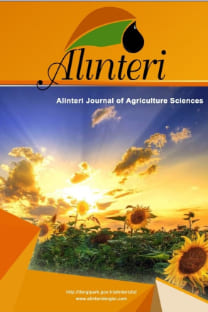Characterization of New Salt-Tolerant Rice Genotypes with Superior Agronomical and Cooking Traits
___
Adamu, T. A., Mun, B. G., Lee, S. U., Hussain, A. & Yun, B. W. (2018). Exogenously applied nitric oxide enhances salt tolerance in rice (Oryza sativa L.) at seedling stage. Agronomy, 8: 276. https://doi.org/10.3390/agronomy8120276Baloch, A. W., Soomro, A. M., Javed, M. A., Bughio, H. R., Aalam, S. M., Bughio, M. Sh., Mohammed, T. & Mastoi, N. N. (2003). Induction of salt tolerance in rice through mutation breeding. Asian Journal of Plant Sciences, 2(3): 273-276. DOI: 10.3923/ajps.2003.273.276
IRRI. (2006). Rice Knowledge Bank. Salt tolerance. Retrieved on 2006 from http://www.knowledgebank.irri.org/ricebreedingcour se/Breeding_for_salt_tolerance.htm
IRRI. (2013). Standard evaluation system for rice: Physiochemical. 5th ed., Manila, Philippines. 55 pp.
Izaddoost, H., Samizadeh, H., Rabiei, B. & Abdollahi, Sh. (2013). Evaluation of salt tolerance in rice (Oryza sativa L.) cultivars and lines with emphasis on stress tolerance indices. Cereal Research, 3(3): 167-180.
Juliano, B. O. (1985). Rice chemistry and technology 2nd ed. American Association of Cereal Chemists, Incorporated Saint Paul, Minnesota, USA. 174p.
Juliano, B. O. & Villareal, C. P. (1993). Grain quality evaluation of world rices. International Rice Research Institute (IRRI), Manila, Philippines. 205p.
Kamyab Talesh, F., Mousavi, S. F., Asadi, R., Rezaei, M. & Khaledian, M. R. (2014). Evaluation of some rice cultivars’ response to salinity stress using resistance indices. Archives of Agronomy and Soil Science, 60(9): 1303-1314. https://doi.org/10.1080/03650340.2014.891730
Little, R. R., Hilder, G. B. & Dawson, E. H. (1958). Differential effect of dilute alkali on 25 varieties of milled white rice. Cereal Chemistry, 35: 111–126.
Mirdarmansouri, Sh., Babaeian Jelodar, N. A. & Bagheri, N. A. (2014). Effects of NaCl stress on grain yield and their components in Iranian rice genotypes. Journal of Crop Breeding, 6(14): 67-83.
Negrao, S., Courtois, B., Ahmadi, N., Abreu, I., Saibo, N. & Oliveira M. (2011). Recent updates on salinity stress in rice: from physiological to molecular responses. Critical Reviews in Plant Sciences, 30(4): 329-377. https://doi.org/10.1080/07352689.2011.587725
Sabouri, H., Rezaei, A. & Momeni, A. (2008). Evaluation of Salt Tolerance in Iranian Landrace and Improved Rice Cultivars. Journal of Agriculture and Natural Resources Sciences, 12(45A): 47-63.
Saeidzadeh, F., Taghizadeh, R. & Gurbanov, E. (2016). Evaluation of salinity tolerance in some of rice genotypes under west region of Guilan province (Astara). Cereal Research, 6(1), 31-41.
Singh, R. K., Mishra, B., Chauhan, M. S., Yeo, A. R., Flowers, S. A. & Flowers, T. J. (2002). Solution culture for screening rice varieties for sodicity tolerance. Journal of Agricultural Science, Cambridge (UK), 139: 327-333. https://doi.org/10.1017/S0021859602002447
Taliyil, V. & Mammootty, K. P. (2010). ‘Kuthiru’ and ‘Orkayama’ – Newly identified genetic resources from Kerala, India for salinity tolerance in Indica rice. Nature Precedings. https://doi.org/10.1038/npre.2010.4561.1
Yichie, Y., Brien, Ch., Berger, B., Roberts, T. H. & Atwell, B. J. (2018). Salinity tolerance in Australian wild Oryza species varies widely and matches that observed in Oryza sativa. Rice, 11: 66. https://doi.org/10.1186/s12284-018-0257-7
- ISSN: 2564-7814
- Yayın Aralığı: 2
- Başlangıç: 2007
- Yayıncı: Adem Yavuz SÖNMEZ
S. RAJESHKUMAR, T. LAKSHMİ, M. THARANİ, P. SİVAPERUMAL
Evaluation of Optimal Area Usage in Kastamonu City Center in terms of Landscape Planning
Sevgi ÖZTÜRK, Merve Kalaycı KADAK
The Impacts of Covid-19: An Econometric Analysis of Crude Oil Prices and Rice Prices in the World
Weed Management in Organic Farming
Estimation of Iron and Ferritin Levels in Oral Submucousfibrosis (OSMF) Patients
Jaya KEERTHANA, Thangavelu LAKSHMİ, Roy ANİTHA, S. Rajesh KUMAR, S. RAGHUNANDHAKUMAR, R.V. GEETHA
Identification and Mapping of Wetland Plants in Erzurum
Main Soil Types of the Çoruh River Basin
HÜSEYİN ESECELİ, TUGAY AYAŞAN, Fisun KOÇ, Vasfiye KADER ESEN, Selim ESEN
Feyza TUNCEL, Nazlı TEKKAŞ, Gökay TÜRK, Hatice Diğdem OKSAL, Hikmet Murat SİPAHİOĞLU
